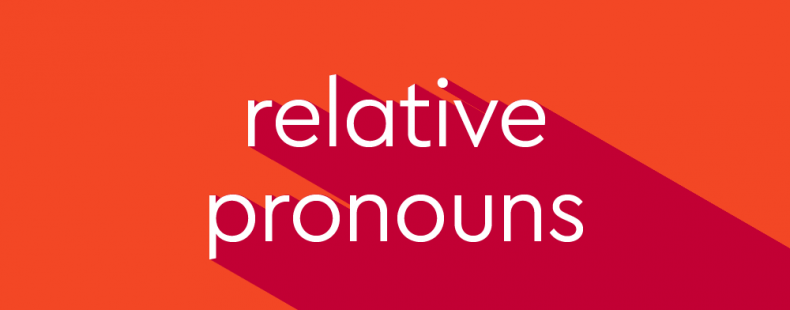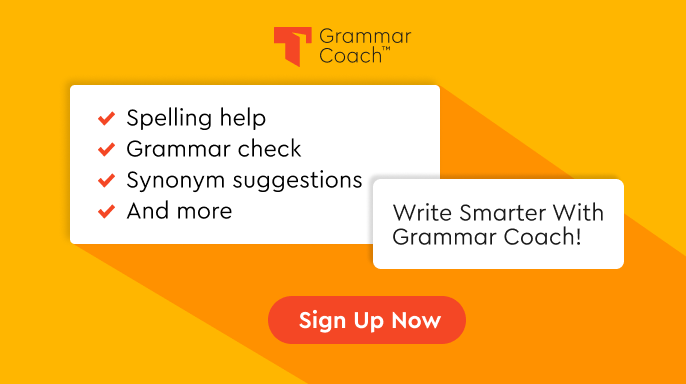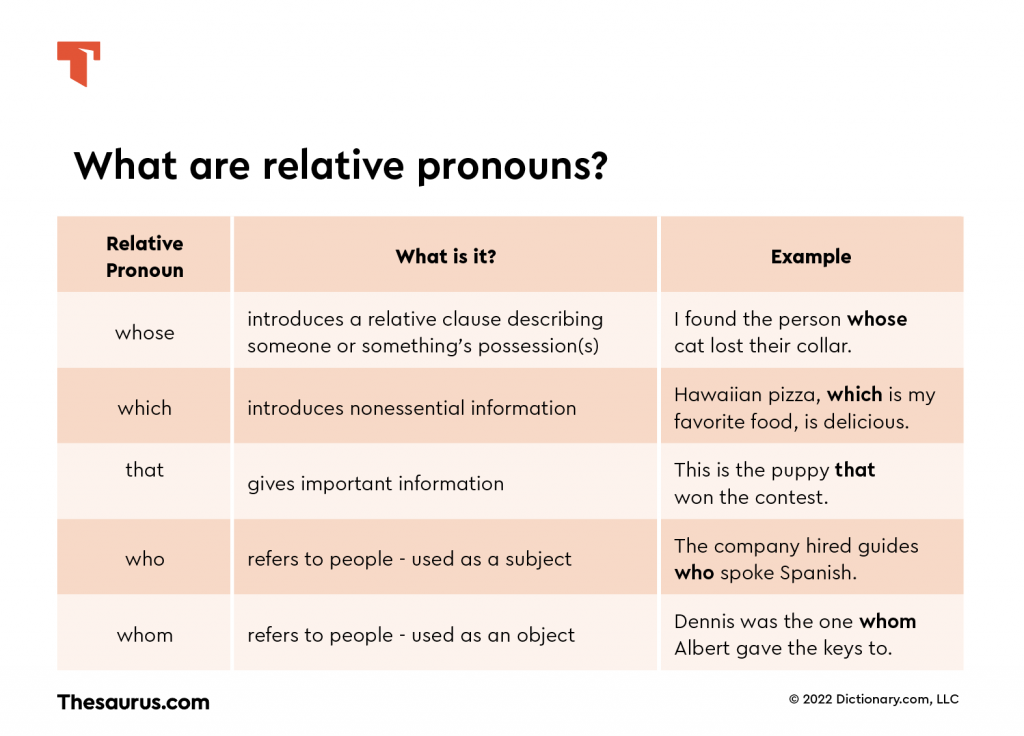Time for some trivia! The reason that plants are green is a substance called chlorophyll. Tortoises, which are reptiles, can live for hundreds of years. Franklin Roosevelt is the president who is on the dime. Okay, that’s enough trivia for now, because we are now going to look at pronouns.
You probably know pronouns replace nouns in sentences and do a lot of the same jobs that nouns do. All our fun trivia facts used a special type of pronoun that we can use to provide additional information about nouns and pronouns through dependent clauses. These pronouns are called relative pronouns. Relative pronouns can really spice up your sentences, as long as you know how to use them correctly. So, let’s learn just how to do that!
What is a relative pronoun?
A relative pronoun is a pronoun that is used to introduce a relative clause. In particular, relative pronouns usually introduce relative clauses that describe nouns or other pronouns. This will be easier to understand if we look at some sentences. For example, the word that is a relative pronoun in the sentence Find me the book that has money hidden in it.
A relative clause is a type of subordinate clause (also known as a dependent clause), which means that it can’t stand by itself as a complete sentence. For example,
Independent clause: Jeff is a friend (The clause can stand alone.)
Dependent clause: who is always there for me (The clause can’t stand alone.)
Relative pronouns typically lead relative clauses and, in a manner of speaking, attach them to an independent clause. For example,
- Jeff is a friend who is always there for me.
In this sentence, the relative pronoun who introduces a dependent clause that modifies the noun friend.
Whose
The word whose is both a possessive pronoun and a relative pronoun. We use whose to introduce a relative clause describing someone or something’s possession(s).
- I found the person whose cat lost their collar. (Whose cat lost their collar modifies the word person. Whose introduces a clause that describes a cat that belongs to the person.)
Which and that
Which and that are used in relative clauses that describe objects or animals. In general, the word which is used to introduce nonessential information and that is used to give important information.
- Hawaiian pizza, which is my favorite food, is delicious. (Which is my favorite food modifies the noun phrase Hawaiian pizza. Which introduces a relative clause that provides nonessential additional information.)
- This is the puppy that won the contest. (That won the contest modifies the word puppy. That introduces a relative clause with important additional information that specifically tells us how the puppy is different from all other puppies.)
⚡️Examples of relative pronouns
Here are some more examples of relative pronouns used in sentences.
- I need to find a roommate who doesn’t smoke.
- The employee helped the customer whom the manager brought over.
- She gave a ride to a tourist whose family was from Sweden.
- The computer, which I bought yesterday, is on top of my desk.
- The uniform that had been worn by Napoleon was on display in the museum.
How to use relative pronouns
When we use relative pronouns, we typically put them immediately after the word that is being modified by a relative clause:
- She was the only student who knew the right answer.
We can also use commas to separate the relative clause from the independent clause. When we do, we typically still try to put the relative clause right after the word it modifies:
- Brian sat in his car, which was parked by a utility pole.
In general, we don’t separate out a relative clause with commas if it is a restrictive clause (it identifies the thing it modifies), but we do use commas if it is a nonrestrictive clause (it describes the thing it modifies). For example,
- Restrictive clause: I found the girl who wrote the note.
- Nonrestrictive clause: Stephanie, who is standing by the door, wrote the note.
Because they are pronouns, relative pronouns almost always introduce subordinate clauses that describe nouns or other pronouns.
- Modifies a noun: The squirrel that I was watching climbed up the tree.
- Modifies a pronoun: Look in the box of papers and hand me one that is blank.
Who and whom
The words who and whom often cause people difficulty. Remember: who is used as a subject and whom is used as an object. A helpful tip to figure out which of these words you should use is to substitute the word they or them and see which makes more sense in a sentence. Whom and them both end in M and are both only used as objects. If it makes sense to use them, it will also make sense to use whom. Let’s look at some examples:
- The company hired guides (who/whom) spoke Spanish.
- Dennis was the one (who/whom) Albert gave the keys to.
In the first sentence, the guides are the ones who speak Spanish. We would say that they speak Spanish so we use the word who.
In the second sentence, Dennis received the keys from Albert. We would say that Albert gave him the keys so we use the word whom.
We use who and whom to refer to people. Some style guides also allow who and whom to refer to named animals. Grammatically, it is considered improper to use who and whom to refer to objects.
✅ Correct: Lisa is the girl whom I like.
Sometimes correct: Cupcake the Elephant was the one who painted this picture.
❌ Incorrect: We went to the house who was at the end of the street.
Looking for more on who vs. whom? Read more about the pair here.
That and which
Both that and which are used to provide additional information. Typically, we use the word which to introduce nonessential information and the word that to introduce important information.
How do you know if you should use that or which? If the information can be removed without affecting the meaning of the sentence, you can use which. If the information is crucial to the meaning of the sentence, you can use that.
For example, we have a sentence that reads:
- The bouquet, which consisted of roses and tulips, looked really beautiful.
If we remove the relative clause, the sentence reads The bouquet looked really beautiful. While we know less about the bouquet, the sentence still expresses the same meaning. It still tells us that the bouquet was pleasant to look at. Because the information is not crucial, we can use the pronoun which.
Now, look at this sentence:
- Pete wanted to buy a house that had a basement.
If we remove the relative clause this time, our sentence reads Pete wanted to buy a house. Unlike before, the sentence has a different meaning. Our original sentence stated that Pete was interested in a specific type of house: one with a basement. Our new sentence says that Pete would buy any house regardless of whether or not it had a basement. Because the relative clause is crucial to the meaning of the sentence, we can use the pronoun that.
All of this means that the pronoun that is almost always used in restrictive clauses. Because of this, it is nearly always considered improper to use a comma before that when it is used as a relative pronoun.
✅ Correct: This is the amusement park that has the tallest ferris wheel.
❌ Incorrect: This is the amusement park, that has the tallest ferris wheel.
While some style guides may claim that which can only be used in nonrestrictive clauses, this is not true. It is perfectly acceptable to use which in both restrictive and nonrestrictive clauses. Just remember that nonrestrictive clauses use commas and restrictive clauses do not.
- Restrictive: The movie which he first made became a smash hit.
- Nonrestrictive: The movie, which had a low budget, was surprisingly good.
Who or whom? Ask Grammar Coach™!
You won’t mistake your pronouns again when you check your writing on Thesaurus.com’s Grammar Coach™. This writing tool uses machine learning technology uniquely designed to catch grammar and spelling errors. Its Synonym Swap will find the best nouns, adjectives, and more to help say what you really mean, guiding you toward clearer, stronger, writing.
Start writing smarter today!
















